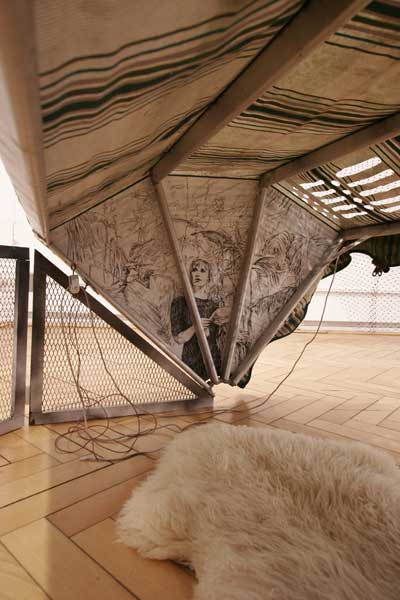 Die Sabinerin, 2005 Canopy, Fur, Wood, etc; size variabel Courtesy Galerie Bob van Orsouw, Zürich Kerstin Kartscher remote bedroom Click for English text Im Rahmen von Suzie Q Projects freuen sich Birgid Uccia und Bob van Orsouw, erstmals in der Schweiz im Rahmen einer Einzelausstellung das zeichnerische und installative Werk der in London lebenden und arbeitenden Künstlerin Kerstin Kartscher (*1966) vorstellen zu dürfen. Im Zentrum der Präsentation steht die Installation "Die Sabinerin" (2005), die aus einer Assemblage von verschiedenen Materialien (Sonnensegel, Pelz, Absperrelemente, Bettzeug etc.) besteht. Auf den ersten Blick denkt man an einen zeltartigen Unterschlupf. Bei näherem Hinsehen erweist sich dieser jedoch nicht als schützendes Refugium, da er nach allen Seiten zugänglich ist. Eher ist man versucht, an das Prekäre und Provisorische von Behausungen zu denken, wie sie Obdachlose bewohnen. Insofern wirkt die Installation ambivalent und fragil. Kartscher scheint vielmehr die Unmöglichkeit eines realen Zufluchtsortes zu evozieren und diesen in der Welt der Imagination und Fiktion zu verankern. Wie sich in den Zeichnungen von Kartscher Heroinen tummeln, gemahnt auch der Titel der Installation "Die Sabinerin" an ein in der Mythologie verankertes Heldinnentum (die von den Römern geraubten Sabinerinnen werfen sich mutig zwischen die kämpfenden Völker und stiften so Frieden). Direkt auf die Innenseite des Sonnensegels ist in Anlehnung an Joseph Losey's Film "Eve" (1962) eine Frauengestalt gemalt. Eve wird von Jeanne Moreau, einer der berühmten Leinwanddiven des 20. Jhd., verkörpert. Das Thema weiblicher Macht und Autonomie in Umkehrung patriarchaler Dominanz zieht sich als inhaltlicher Leitfaden auch durch die Zeichnungen. Die Zeichnung stellt ein eigenständiges Medium für die Künstlerin dar, das weder als Skizze noch als Vorstudie fungiert. Ähnlich wie in den Installationen werden durch den Einsatz architektonischer Versatzstücke und verschiedener Wirklichkeitsfragmente parallele Bildwelten erzeugt. Tropische Vegetationen, phantastische Landschaften und traumähnliche Begebenheiten rufen Assoziationen an imaginäre Räume wach. In diesen scheinen Raum und Zeit auf einen unbekannten, privaten Kosmos hin entgrenzt, der den Betrachter in seinen rätselhaften Bann zieht. Die Zeichnungen werden von einem Duktus dominiert, der an die klare Linienführung japanischer Holzschnitte oder an Illustrationstechniken denken lässt. Im Katalogbeitrag von Jan Verwoert zu Kartschers Einzelausstellung in der Tate, St. Ives (2005/06) heisst es: "Each drawing is a theatre of the mind [...] to which one can retreat and be free to dwell on feelings and thoughts which the outside world leaves little room for". Birgid Uccia Ausstellungsdauer 15.3. - 3.5.2008 Öffnungszeiten Di-Fr 12 - 18 Uhr, Sa 11 - 17 Uhr und nach Verabredung Suzie Q Projects Birgid Uccia / Bob van Orsouw Limmatstrasse 265 8005 Zürich Telefon +41 (0)44 273 03 00 Fax +41 (0)44 273 03 04 Email info@suzie-q.ch www.suzie-q.ch Kerstin Kartscher remote bedroom Within the framework of the Suzie Q projects, Birgid Uccia and Bob van Orsouw are pleased to present the first solo exhibition in Switzerland of the drawings and installations of Kerstin Kartscher (*1966), who lives and works in London. At the centre of the presentation is the installation "Die Sabinerin" (2005), composed of an assemblage of various materials (an awning, an animal pelt, barrier elements, bedding, etc.). At first sight it recalls a tent-like refuge. A closer look proves it is in no case a protective shelter, since it is open on all sides. One is more inclined to see in it the precarious and provisional encampment of a habitat for the homeless. To this extent the installation appears ambivalent and fragile. Kartscher seems here to be evoking the impossibility of a genuine haven, rooting it, instead, in the fictive world of the imagination. Just as heroines crowd Kartscher's drawings so does the title of the installation "Die Sabinerin" summon up the heroism anchored in mythology (the Sabine women abducted by the Romans bravely threw themselves between the warring factions' battle lines, bringing about peace). Directly on the inside flaps of the awning a figure of a woman is drawn in analogy to Joseph Losey's film "Eve" (1962). Eve was played by Jeanne Moreau, one of the famous screen divas of the 20th century. The theme of female power and autonomy in a reversal of patriarchal dominance also runs as a leitmotif through Kartscher's drawings. The artist treats the drawing as an autonomous medium that is neither a sketch nor a preliminary study. As in the installations, the depiction of architectural props and various fragments of reality generates parallel worlds. Tropical vegetation, phantasmal landscapes and dream-like episodes call up associations of imaginary places where space and time open into an unknown, private cosmos that weaves a mysterious spell over the viewer. The drawings are dominated by a style that recalls the clear lines of Japanese woodcuts or illustration techniques. In his catalogue contribution to Kartscher's solo exhibition at the Tate, St. Ives (2005/06), Jan Verwoert wrote: "Each drawing is a theatre of the mind [...] to which one can retreat and be free to dwell on feelings and thoughts which the outside world leaves little room for." Birgid Uccia Exhibition 15 March - 3 May 2008 Gallery hours Tues-Fri noon - 6 pm, Sat 11 am - 5 pm |